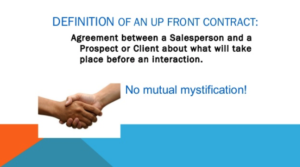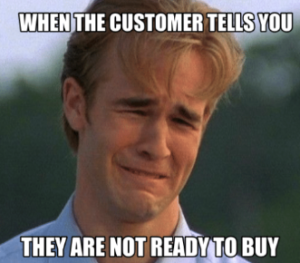Mastering the art of sales questions: a comprehensive guide
Are you looking for a rich list of sales questions you can use today?
Sweet, because we have you covered.
Not only that, but you’ll also learn how and when to use these questions.
In fact, we’re going to start with that foundation.
Master sales pros know that this skill is as important as what they ask. It sets the tone to conversational.
Take the advice below and shift your line of questioning. You’ll see a massive improvement in the outcome of your discovery calls.
(PS: We’re giving away tactics only the top 5% of sales pros know in our new Sales Success Master Class).
Start Every Deal with a Contract
People know within seconds whether they trust you.
That’s true in face-to-face meetings and on discovery calls.
So stop diving into yes/no, low-value questions right after small talk. It comes across as interrogative and lowers the perceived value of your conversation.
Instead of trying to get information right away, set the table for a two-way discussion.
Do that with an upfront contract. Here’s what you might say:
“Today we’re going to see whether our product is a strong fit for you. That way, if you go further in this process with us, you’ll know it’s time well spent. If I see that it’s not a great fit for you, I’ll be upfront about it so we both save time. Is that fair?”

Once the buyer agrees to the contract, figure out where they are in their buying journey.
Then you can ask appropriate questions … IF you’ve earned the right to ask them at all.
How to Earn the Right to Ask Sales Questions
Ever been knee-deep in a discovery call only to have someone interrupt with “Can you just show me the product?”
Ugh. It stings, I know.
You’re only doing your job—why won’t they play ball?!
This tension happens when you haven’t sold them on the value of answering your questions.
How do you do that?
It depends on whether your deal is inbound versus outbound.
For starters, outbound leads are usually in the latent pain stage. That means they don’t yet view their business challenge as a priority worth solving.
So instead of diving into questions, it’s helpful to start with a discovery prompt.
That’s a 2-3 minute narrative about the problem or opportunity your company solves.
After the prompter, pass the torch to them and ask
“Enough about us. Tell me about what you’re biggest business challenges are as it pertains to ___ (context of your offering).”
Now let them talk.
If done correctly, their guard will lower because they now view time invested with you as a means to getting closer to solving their business objectives.
After you’ve done this, the coast is clear to ask questions like the ones below.
Inbound leads are different. They have active pain, and they’re actively exploring solutions. This is because they already accept that they have a challenge worth solving.
So selling them on the value of answering your questions requires a different approach (in fact, a discovery call prompter will actually hurt you).
These buyers are further along in their journey, so you can focus your sales questions on the business outcomes they want to achieve.
They key is to ask them questions that meet them where they stand.
In other words, ask them questions about how they’re evaluating solutions.
For example:
- Help me understand what you’re hoping to accomplish by rolling out ___ (tool/ category)?
- What’s your decision criteria?
- What’s most important to you as you evaluate vendors?
Notice you can’t – and shouldn’t – ask this to outbound leads.
Are you starting to get the difference here?
Ask Sales Questions the Right Way
Here’s the key to leveling-up your discovery skills.
It isn’t introducing new questions into your arsenal.
It’s about reframing your questions to elicit the responses you want.
The first step is getting longer responses.
There’s a clear correlation between longer responses and success rates.

Why? Because the longer their answers, the more information you gather.
And the more information you have, the better your chances of building a bullet-proof reason to buy your offering.
Here are sales questions that generate long responses:
- Context: What’s changed since the last time we spoke?
- Pain: Last time we met we talked about solving [business challenge 1 and 2]. What’s missing from our list that’s worth covering today?
- Impact: How is this presenting itself as a problem to the business?
- Current state: How are you currently addressing [pain/problem]?
- Quantify impact: What would happen if we solved [business challenge]?
- Qualification: When evaluating a technology partner, what’s most important to you? Get 43 more sales qualifying questions here.
- Timing: What happens if we don’t address this [pain/challenge] now?
- Influencers: Who would feel left out if they didn’t attend the demo?
- Potential blockers: Who else will these changes affect?
- Buying process: Walk me through how you purchased [incumbent].
These questions motivate long-winded responses and extract critical information.
Advanced Sales Questions for Pro Sellers
With a renewed list of go-to questions, you run the risk of asking too many questions.
The key to masterful discovery is leveraging high-impact sales questions.
In other words, it’s not a volume game.
It’s a quality game.

For example, when you’re speaking with a c-suite executive, there’s a significant drop in success rates after just a few questions.
Again, if you’re using well-framed, open-ended questions, you’ll find that a handful is enough to unpack your prospect’s business needs.
But wait, we’re not done yet!
When you ask questions is as important.

Top reps spread their questions out across the conversation, curating natural conversations.
Conversely, average reps construct conversations that feel like interrogations. This is because they front load their questions in the beginning of the call.
This negatively impacts the outcome. It leaves prospects feeling defensive and doubtful that they’re going to get a good return on their time and energy.
To reduce your risk of asking too many questions, mix the conversation up with labeling and mirroring.
Popularized by Chris Voss in his book, Never Split the Difference, mirroring and labeling are expert-level techniques used to pluck out key information without actually asking a question..
Mirroring is repeating the last 2-3 words or the most critical words your prospect says.
Then you upwardly inflect the phrase so it sounds like a question.
Buyer: There’s no way we could make a vendor switch until next year.
Seller: Next year?
The inflection is critically important.
The reason this works so well is because you’re using their words, not your words.
If done well, your prospect takes it as a prompt and elaborates on the reasons behind their statement.
Now you have information you’d never have otherwise.
Labeling is when you name the emotion your buyer is expressing.
This helps when the conversation becomes contentious. That’s when it’s your turn to say:
- It seems like you …
- It sounds like you …
- It looks like you …
It goes something like this:
Buyer: I see value in your product, but I have too many competing priorities to take this on right now.
Seller: It seems like you’re hesitant to disrupt your current tech stack.
Now stop talking. You’ve done your work (for now).
The floodgates will open and they’ll give you a detailed response because they feel understood.
When people believe you understand them, they are more honest about their concerns and interests. This helps you understand the hurdles in your deal – and how to overcome them.
Interweave these sales tactics with your polished questions. Your prospects will see you as a business consultant they can trust (and buy from).
Ask Your Sales Questions like a Seasoned Veteran
GREAT sales questions define your deal and BAD sales questions kill it quickly.
Have you ever heard the phrase “You get delegated to the person you sound like”?
If your questions are simple, you’ll get pushed to lower-level contacts.
But if you ask questions that make your prospects think? You’ll gain their trust and a warm introduction to the decision maker.
Here’s what that difference sounds like:
Don’t: What’s your sales process?
Do: Can you walk me through your sales process from first contact to close?
The wording is key here, as the latter example reflects a higher level of expertise.
People buy from you when they trust you, and positioning yourself as a domain expert fuels that perception.
Sales Questions to Uncover Something New at Every Turn
Discovery does NOT stop after the first call.
If you’re not uncovering new information, your deal is dying.
Discovery is a strategy, not a step in the process.
And it’s definitely not a list of discovery questions to burn through like rapid fire.
Lots of reps stop asking questions when they enter the next phase of the funnel.
WHY?
This approach assumes that you learned everything you need in your first call and that the world is a static place where nothing changes.
The reality is that your deal is dynamic. It’s always changing, and that means new risks crop up.
That’s why you need to extract the ‘unknown’ at every stage in your deal. (Shout out to Chris Voss for teaching me this critical point.)
The “unknown” is an unexpected hurdle that hits every deal. If it’s not handled well, it throws everything off course and introduces major risks.
It could be a CFO on vacation when you expect a signature.
It could be a blocker in a different department who has influence over your deal.
It could even be a company-wide initiative to pause spending for the rest of the year.
All these things can kill a deal, which is especially heartbreaking if you’ve invested countless hours in an opportunity.
The best way to control your deal is to uncover the “unknown” before it surprises you.
Here’s how you uncover those landmines.
Mid-funnel sales questions to ask in your next meeting:
- If I sat down with your [CEO/boss] and asked what their top three priorities are, what would they say?
- If I could wave a magic wand and improve one KPI, which one would you want it to be?
- What do you find the most interesting about this offering?
- Where does solving [business challenge] sit on your priority list?
- Does [your solution/product] completely address [business challenge]?
- Who will champion this solution?
- What’s missing from our solution as it stands today?
These questions will uncover details that boost your close rates.
Now that your deal is on the line, it’s time to close.
Sales Questions to Close Your Deal Like a Pro
Deal navigation is a nuanced skill you execute throughout the sales process.
Knowing how, when, and what to ask is essential in the back half of your deal.
That’s when you sell yourself as a true business consultant.
How to Get Them to Sign On Time
The number one reason deals slip is—once again—misalignment.
It happens when you and your buyer are at different places in the evaluation process.
You’ll know that’s happening when you go for the close but get hit with the dreaded “We’re not quite ready yet.”

You saw the signature at the end of the tunnel, but now they’re not ready.
Not ready?!
You did the discovery dance, the demo was a hit, and they have the right pricing. What’s missing?
Their response signals that something’s happening behind the scenes, and you have no idea what it is.
This confusion steals all control over your deal.
When you lack control, hope becomes your plan.
But hope is not a strategy.
You need to regain control, or your deal is doomed.
Here’s a list of closing sales questions:
- Under what circumstances can we execute an agreement by [date]?
- Do you see a world in which you move forward in July?
- When does [decision maker] say yes?
- What could prevent a [date] sign date?
- What exactly happens between getting the green light and signing the agreement?
- What obstacles could prevent you from moving forward?
- Are you concerned that we won’t make our [date] timeline?
- It seems like urgency around this initiative has slowed. What’s changed?
Add these questions to your closing motion, and you’ll drastically cut the number of deals that slip away each quarter.
Here’s What To Do Next
You’re now equipped with sales questions that will improve your close rates.
BUT sales questions are just a fraction of what it takes to close a deal.
Our FREE Sales Success Master Class is designed to guide you through the steps of reaching President’s Club status.
Here’s exactly what you’ll learn:
- Advanced discovery tactics for every selling situation
- 7 elements of insanely persuasive demos
- How to tell customer stories that create pain and urgency (and get buyers to sign)
Access the master class for free HERE

